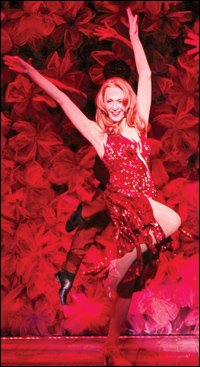
*
A not-particularly-funny thing happened to Follies star Jan Maxwell on the way from the Kennedy Center's Eisenhower Theater (occupancy: 1,100) to Broadway's Marquis Theatre (occupancy: 1,611): She found a tiny window of opportunity to do a no-frills play by a pet playwright of hers at Off-Broadway's Atlantic Stage 2 (occupancy: 117, if you're lucky). Of course, she went for it.
In Howard Barker's Victory: Choices in Reaction, she was a widow of the English Restoration, roaming the countryside collecting for burial the body parts of her magistrate husband, who'd been drawn, quartered, sliced and diced for signing Charles I's death certificate. Multitasking, she also tried fending off the vulgar advances of a horny cavalier (Robert Emmet Lunney), who impregnated her and wound up in her care, tongue-less and wrecked by the rack. "In some ways, I prefer him now," her character remarked after all this abuse. "He was awfully — boisterous — before." Loveland it's not.
All the above took 165 minutes to perform — five more than Follies, which Maxwell rehearsed by day while performing Victory by night.
This sort of acting choice has made Maxwell one of New York theatre's most respected actresses. There's a beguiling mix of intelligence and elegance about her, plus a pinch of raunch, that makes producers look no further in recasting roles played by Eleanor Parker (The Sound of Music), Carole Lombard (To Be Or Not To Be), Rosemary Harris (The Royal Family) and Alexis Smith (Follies). Those last three plays, plus 2010's Lend Me a Tenor, make this Maxwell's fourth Broadway show in a row with a theatrical backdrop. She's Phyllis, a leggy blonde showgirl from the 1940 follies and the uppermost bauble on Stephen Sondheim and James Goldman's melancholy monument to a bygone Broadway. She and fellow former chorine Sally (Bernadette Peters) return to the scene of old glories with unhappy husbands in tow (Ron Raines and Danny Burstein) and ghosts of their younger selves.
| |
 |
|
| Maxwell in Lend Me a Tenor. | ||
| photo by Joan Marcus |
"In rehearsal, I wondered about the hierarchy," recalls Maxwell. "Sally and Phyllis were chorus girls. They were there just a couple of years, if that — and then only as background for Hattie [Jayne Houdyshell], Solange [Mary Beth Peil] and Carlotta [Elaine Paige]. Those were the people who had the specialty acts in the follies in the 1930s and '40s. When Stella [Terri White] did her big 'Who's That Woman?' number, that was her number, and we all just came on and tap-danced behind her."
The big names did not pack big egos for the 10-week Washington, DC run, she says. "Everybody looks for catty stories, but we liked each other — sometimes adored each other — and had a lot of laughs. We all had to get there every morning at 10 and put tap shoes on. When you've got all these divas in a room tapping away, it levels the field."
Oblivious to the fevered cult that encircles the show, Maxwell settled naively into the star spot of Follies, nudged there by her knowing agents. "I'd done Side by Side by Sondheim in college [in Moorhead, MN] so I knew some of the songs," she confesses rather quaintly, "but I didn't really know the show, so I read it and listened to it. A chance to sing 'Could I Leave You?' is hard to pass up."
| |
 |
|
| Maxwell in Follies. | ||
| photo by Joan Marcus |
Which makes for a fuzzy finale. "I like that, because it's not this tied-up bow at the end. You don't know what's going to happen to these couples. They don't end happy. They don't have a button. This was very innovative in the '70s. What I like about it from an acting standpoint is that it's real, and what I love about Sondheim's music is that it continues the scene. It doesn't stop the scene. Songs flow from the dialogue."
Maxwell got her first footing on Broadway in song and dance as "one of the ones who replaced Dee Hoty in City of Angels. Then I went to Goodspeed to do another musical, Here's Love. I was kinda worried because I didn't want to be pigeonholed just in musicals, and it has been a very conscious choice not to be."
Dancing at Lughnasa (a Brian Friel play and not a musical) turned the boat around. "My husband, who had acted with me [the aforementioned Robert Emmet Lunney] talked me into seeing the casting director." The upshot: she followed Brid Brennan into the Tony-winning part of Agnes — and became one of the best actresses around, nonmusical or not.








